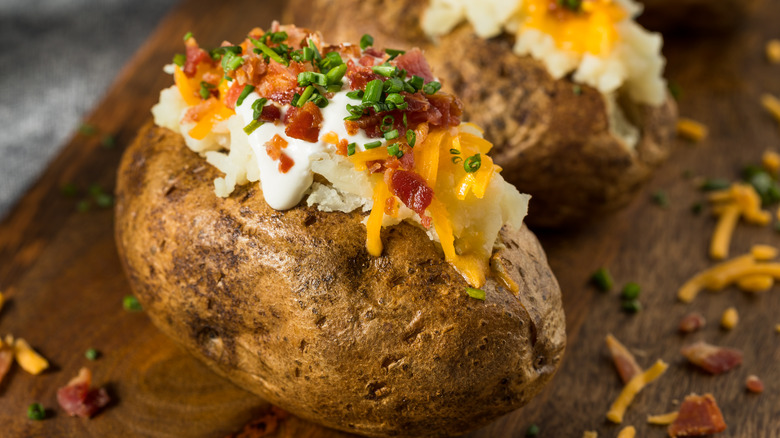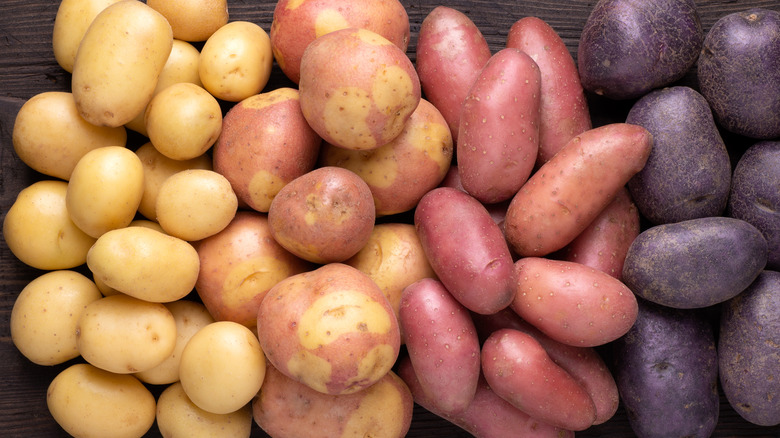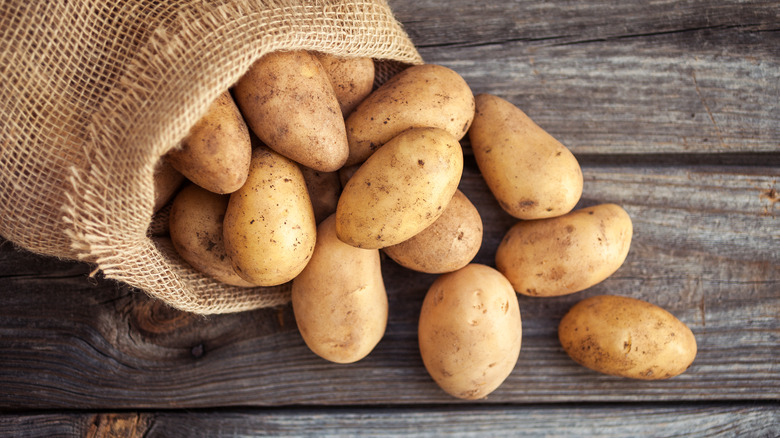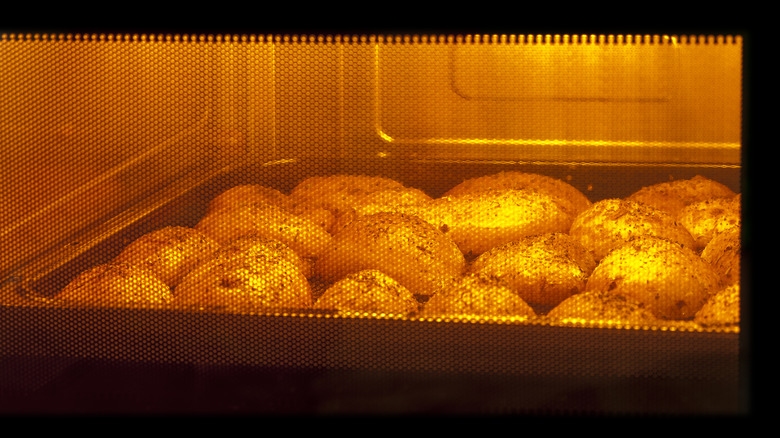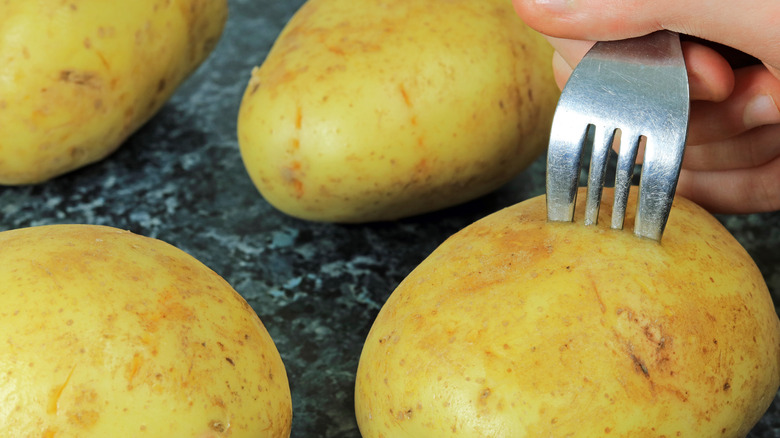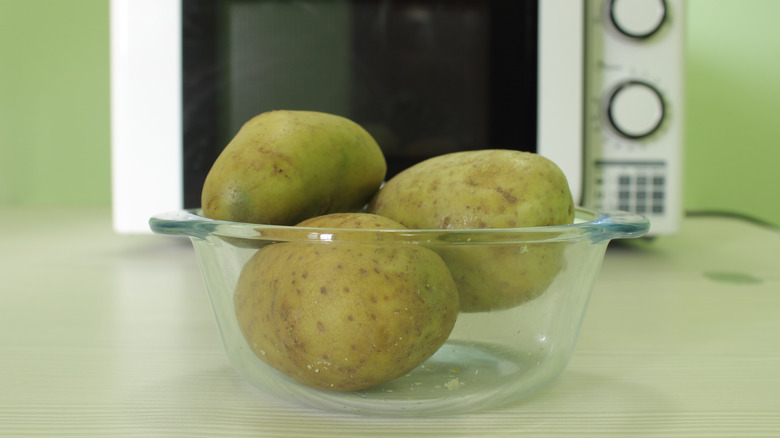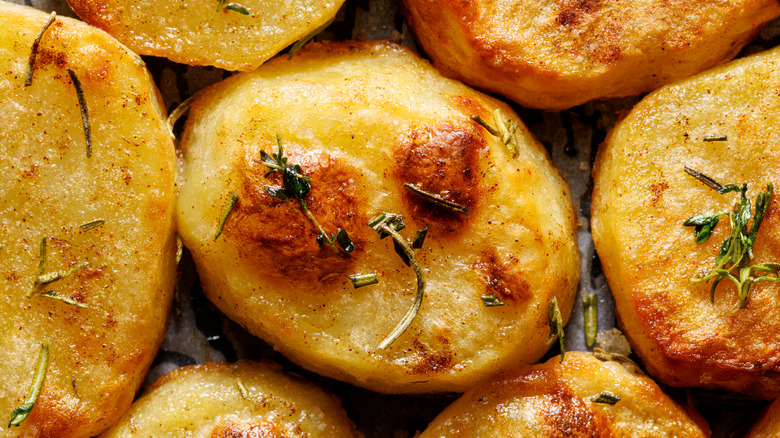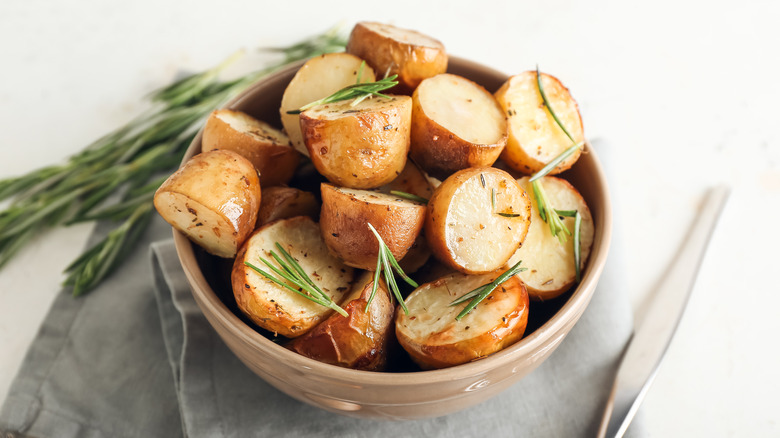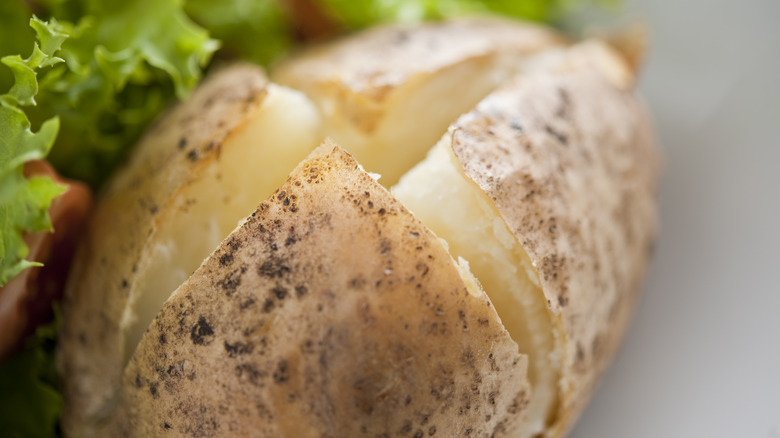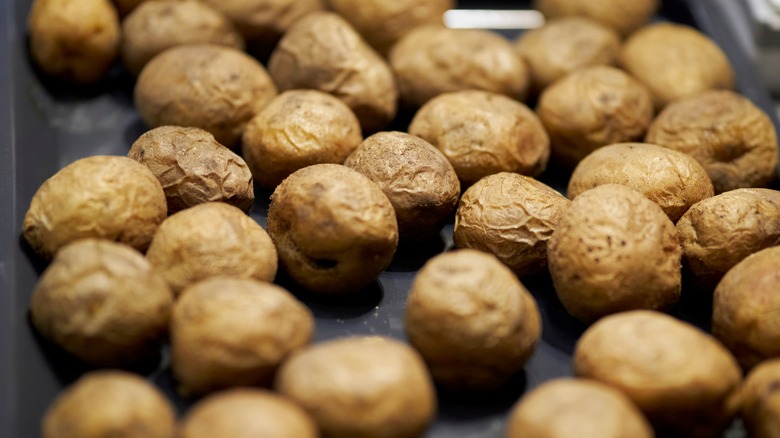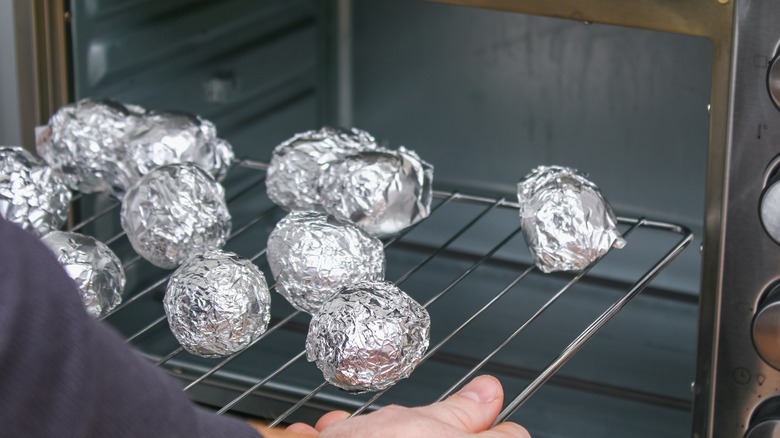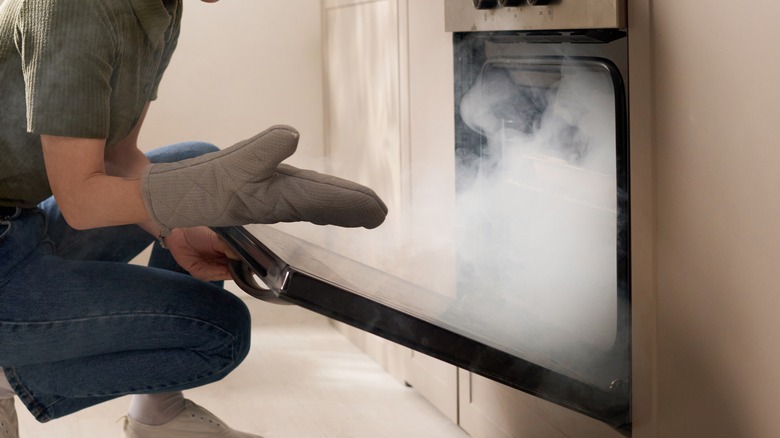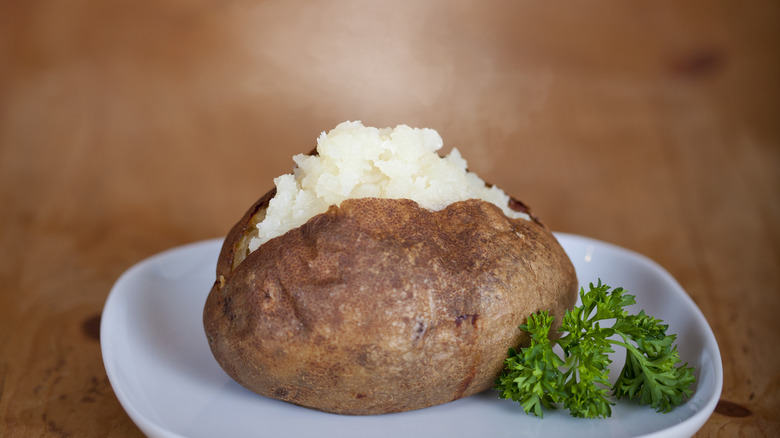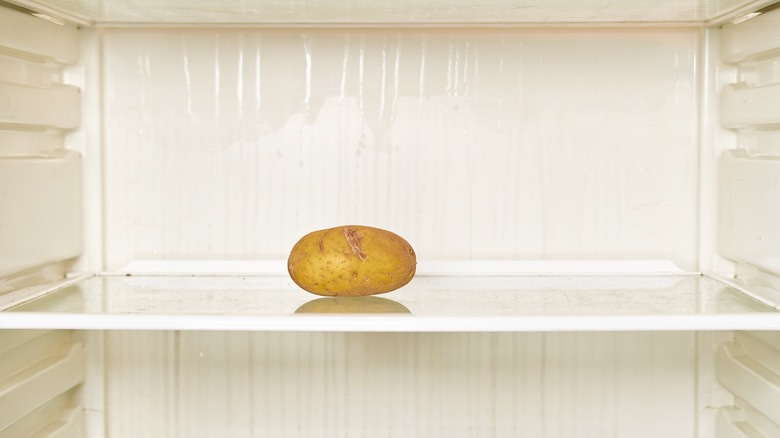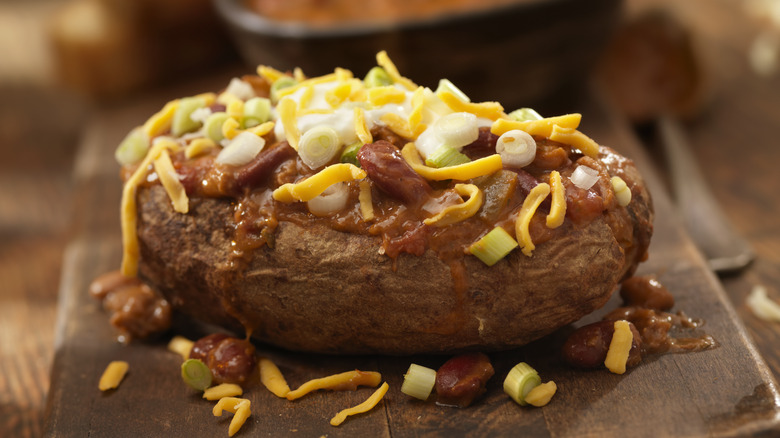The Baked Potato Mistakes You Need To Stop Making
Baked potatoes are a classic and timeless comfort food. With their wonderful light and fluffy texture, earthy, nutty, slightly sweet flavor, and rich and enticing aroma, they pack everything we crave in a great side dish. Pair them with a beautifully grilled steak, a moist and succulent piece of salmon, or a crisp and refreshing side salad, and you've got everything you need for one incredible meal.
But despite their inherent simplicity, making a world-class baked potato is more challenging than it might seem. Sure, it's hard to mess up sticking a potato in an oven and letting it cook until tender — but there are some common blunders everyone makes, even when completing this simple act.
From our choice of spuds and the oven's cooking temperature to how we prepare those taters before sticking them in the oven, here's a look at the baked potato mistakes we all need to stop making.
Choosing the wrong potato
While some potatoes can turn into an extraordinary meal after 60 minutes in a hot oven, others end up a dense and gummy mess. Russet potatoes fall into that former group — they're often considered one of the absolute best spuds you can bake due to their high starch content and inherently low moisture level. This perfect combination produces a soft, fluffy interior and crisp, delightful skin once baked. Russets also absorb toppings well, helping them take on the taste of butter and spices and creating the ideal — and classic — baked potato experience.
Yukon Golds are another perfect option for baking. With a slightly lower starch content than Russets, they can be even creamier and smoother, and their thin and mellow skin is ideal for folks who enjoy eating peel with their baked potato.
While not a traditional choice, sweet potatoes are one more delectable baking option. Their naturally sweet flavor grows even more intense once cooked. Top them with butter, sour cream, and chives for a savory take, or emphasize their sweetness with a dollop of butter, cinnamon, and brown sugar.
On the other hand, red potatoes, fingerlings, and new potatoes are all poorer choices for baking. They tend to have a waxy texture and a higher moisture content, which leaves them tasting slightly dense and gummy after they've been baked. Use them for boiling, roasting, or as the base for a tart and creamy mayo-based potato salad.
Using old potatoes
After selecting the variety of potatoes you'd like to bake, it's important to consider the freshness of those spuds. The older the potato is, or the longer you've had it in your pantry, the less ideal an option for baking. As potatoes age, their starch content changes. Some of that starch begins to convert to sugar, which can alter the potato's taste and texture. This sugar can also promote uneven browning during baking and may give your final potato a slightly "off" flavor. Older potatoes also tend to have a drier and more mealy texture, making them much less appealing when cooked.
To easily eye the freshness of your potatoes (if you don't remember when you bought them), look for signs of sprouting, wrinkling, or any weird greenish tint on their surface. These are all common indicators that a potato has been in storage for a while. Fresh potatoes tend to have a firm and smooth texture; soft spots or a spongy texture are two more signs that a potato has aged considerably since it was harvested and won't make for a good baked potato.
The shelf life for potatoes is about two to three months. You don't have to trash potatoes that are nearing that date — just don't bake them. They can be used in soups and stews or even cooked and mashed. Both cooking methods are much more friendly for the older veggies. Just be sure to trim any spots or eyes (sprouts) before you cook them.
Baking your potato at the wrong temperature
While placing a potato in a pan or on a cookie sheet and putting it in the oven is a pretty straightforward process, some common mistakes can be made along the way. Chief among them is the temperature at which you cook your potato. For the best-tasting baked potato possible, always let your oven preheat rather than shoving your potatoes into a still-cold stove. Preheating ensures that your potato cooks more evenly, allows you to control the timing of your potato's doneness, and helps to prevent the outside of your potato from becoming too crispy before the interior is fully cooked.
The ideal oven temperature for baked potatoes is around 400 degrees F, depending on how soft you like your potatoes and the size of the potatoes you're baking. For smaller or firmer potatoes, use a slightly lower temp. For larger potatoes, you may want to opt for a slightly higher temperature.
As for cooking time, most medium-sized baked potatoes are ready after 50-60 minutes. Smaller potatoes will cook faster, and larger potatoes can take considerably longer, depending on their size. To check for doneness, grab a fork; if it goes into the flesh of the potatoes easily, they're ready to serve.
Not pricking holes in the potato
Forks are an essential tool for determining the doneness of a potato once it has been baking for a while, and they serve another important function as well: they can speed up the cooking time considerably.
Once you've washed and dried your baked potato and you're ready to put it into the oven to cook, pierce holes all over your potato with the tines of your fork. The holes should be evenly spaced on all sides, going through the potato's skin and poking at least half an inch into its flesh.
These holes allow steam to escape from your potato more efficiently as it cooks. The release of steam — and moisture — also enables heat to penetrate the potato's interior more easily, thereby speeding up the cooking process of your potatoes significantly. These holes also help reduce pent-up pressure within the potato, allowing more even and effective baking as well.
Baking cold potatoes
In addition to piercing holes into the skin and flesh of your potato, there are other ways to speed up the baking process. You can cut larger potatoes into small portions and bake them instead. You can also parboil your potatoes, which means submerging them in boiling water for a few minutes before you bake them (which also helps to make them crispier once cooked). Perhaps the best and most effective way to cut time off from how long it takes to make a baked potato is to microwave your potatoes before you put them into the oven.
Microwaving potatoes before baking is an ingenious way to expedite the cooking process. Warming potatoes in the microwave jumpstarts how quickly the internal temperature takes to rise. This allows the oven's heat to penetrate the potatoes more quickly, so they cook faster and require less time in the oven overall.
To nuke your potatoes and save a few added valuable minutes of cooking time, first go ahead and pierce a potato all over with a fork. Then, put it on a microwave-safe plate, cover it with a paper towel, and microwave on high for five to six minutes, depending on size. Double that time for multiple potatoes. Once warmed, your spuds should go immediately into the oven so they don't lose any of that essential built-up heat. Just be careful moving them; they'll be hot, so you'll need an oven glove or mitt.
Baking potatoes together that are not uniform in size
Finally, if you're looking to speed up the time it takes to bake potatoes for a meal, make sure all the potatoes you're cooking are of similar size and shape. Grabbing a bunch of differently sized or non-uniformly shaped potatoes and trying to cook them all together is a mistake that many of us are guilty of — and it's so easy to avoid.
Of course, you can cook potatoes of any size together simultaneously if you want or if that's all you have on hand, but for the most efficient and lowest hassle baking, you get much better results when you select the most uniform batch of potatoes possible. The advantage here is obvious. When potatoes are of similar size and shape, they're more likely to cook to the ideal level of doneness in approximately the same amount of time. If you are feeding a group, you won't have to worry about one person's potato being overcooked and another being undercooked. When one potato is done, your entire batch of baked potatoes is typically done.
Not using a rub or proper seasoning
Baked potatoes on their own can sometimes end up very bland. That's why it's a mistake not to include rubs and marinades as part of your baked potato repertoire, at least occasionally, for a burst of added zestiness and pizzazz. Like the flavorful salt and herb-packed rubs you use on a good cut of beef or chicken, baked potato rubs typically contain a blend of herbs, spices, and sometimes oil. They're an excellent way to add depth and complexity to the flavor of a baked potato, especially when you massage them into the skin so that they fully permeate the potato's interior as it bakes. For a savory twist, your rub might include olive oil, garlic powder, paprika, thyme, and rosemary. Or, for more of a smokey barbecue essence, consider a rub made with brown sugar, smoked paprika, cumin, and garlic.
Like rubs, marinades are another powerful way to create even more intense flavors and can completely change the taste of a baked potato into something new, unexpected, and exciting. A basic marinade might include olive oil, balsamic vinegar, Dijon mustard, and minced herbs. Or, for more of a Mediterranean-style baked potato, use a mixture of olive oil, lemon juice, oregano, salt, and chicken broth.
After applying a rub or marinade to raw potatoes, let them soak in the herb-infused mixture for at least 20 minutes. The longer they sit, the more intense the flavor becomes.
Baking a potato that's too wet or oily
Whether you're just washing and drying your potato before you bake it, coating it with a thin layer of oil, or using a marinade for even more flavor, it's crucial never to try to bake a potato that's excessively wet or oily.
Excess moisture hinders the formation of that highly coveted crispy skin and negatively impacts the overall texture of the potato. Essentially, it steams the potato as it cooks rather than allowing it to bake. This can leave the potato mushy, robbing it of its desired fluffiness and creating a soggy consistency.
To avoid mistakes triggered by too much moisture when baking any potato, always thoroughly dry potatoes after washing. If you marinate potatoes before baking, ensure the marinade doesn't introduce excessive liquid to your spuds. Opt for a well-blended marinade that adheres to the potatoes without truly soaking in. Most importantly, when you remove potatoes from the marinade, let them drip dry before baking. You should never let your potatoes cook in a pool of excess liquid — you'll end up braising your potatoes instead of baking them.
Overcrowding the oven
Overcrowding the oven can be detrimental to the quality of your baked potatoes in many ways. When spuds are placed too close together on a baking sheet or within a pan, the circulation of hot air within the oven (and around your potatoes) is impeded. This triggers uneven cooking and issues with texture and crispness. Lack of proper air circulation can also promote browning, leaving some areas undercooked and others overly crisped or burnt.
To avoid overcrowding, always ensure ample space between each potato you're baking and its nearest neighbor — at least an inch or two, more space if possible. This is the best way to ensure the oven's hot air flow circulates freely. If you need to bake a large quantity of potatoes, you can cook them in batches, spread them out on two different layers within your oven, or at least stagger them on your cookie sheet to promote air circulation.
To foil or not to foil?
Should you use foil when cooking a baked potato? That's a topic of much debate in the world. According to foil enthusiasts, one of the biggest advantages of using foil when baking a potato is that the foil provides a small barrier around the potato and oven, helping to trap heat next to the tater's tender flesh. When potatoes are exposed to this added heat, they cook more evenly and bake faster. This "oven-within-an-oven" effect also helps trap extra moisture around the potato, preventing it from drying out during baking and creating a softer, more succulent interior.
For the anti-foilers, though, there are plenty of reasons to skip that added layer of foil around a potato. Instead, these folks like to bake their potato "naked," directly on the rack or on top of a pan or cookie sheet. When a potato isn't wrapped in foil, the spud gets more direct exposure to the oven's dry heat. Instead of steaming, the skin or peel of the potato instead becomes much more crunchy. This is how many Brits and other Europeans prefer their "jacket potatoes" — extra crispy on the outside, fluffy on the inside.
Which is best? Let your taste buds guide your ultimate decision.
Over and undercooking
A perfectly baked potato should have a delightful crisp and golden-brown skin that packs a satisfying crunch when you bite into it. Beneath that peel, you should find a rich and earthy interior with a hint of sweetness that intensifies with every bite.
Overcooked and undercooked potatoes lack this harmony of texture and flavor. When a potato hasn't been baked long enough, it has a stubborn hardness that makes it challenging to eat. The texture is rough and uneven, and the flesh is harder to mash and enjoy. On the flip side, an overcooked potato might seem mushy or waterlogged. Or it can be incredibly dry, verging on burnt. Essentially, both are inedible.
To avoid ending up with either, test your taters' level of doneness every few minutes during the last 15 minutes of baking. A perfectly cooked potato will have soft skin that pierces easily with a fork, revealing a fluffy and tender interior underneath. The skin should look golden brown and crisp, without unusual blotches or mottling.
Not allowing the potato to rest after it comes out of the oven
When your baked potato is finally cooked to perfection and ready to eat, there's one more critical step to remember. Like a good steak that needs to rest for a few minutes before you slice into it, baked potatoes also need a brief resting period before being served.
Giving a baked potato time to rest before you cut it open ensures your potato provides the most crave-worthy taste and texture possible. Once you remove any type of baked potato from the oven, let it rest on the stovetop for approximately five to 10 minutes. During this resting period, residual heat within the potato will continue to work its magic, wrapping up the cooking process and allowing the interior to settle fully and its starches to firm up slightly. This short resting also promotes fluffiness within the potato and enables the skin to crisp up more as that final bit of residual steam escapes, reducing potential sogginess.
To determine when your potato has rested enough and is ready to eat, squeeze it gently. The skin should feel satisfyingly crisp, and the potato should feel tender and warm — not too hard and not too soft. Then, let the feast begin!
Storing cooked baked potatoes uncovered in the fridge
Cooking extra baked potatoes is a great way to save time — you can just grab your already cooked spud for lunch the next day. But if you are baking and plan on having leftovers, don't just toss those taters into your fridge uncovered or still wrapped in aluminum foil. If you do, your potato may become either extra dry or mushy. It also poses a food safety risk and could allow bacteria to develop.
To safely store a baked potato in the fridge, first let your potato cool completely. Take off any wrapping (if you used foil during baking) and remove any toppings (if it had already been prepared or served). Finally, put the potato into an airtight container or resealable bag.
Use a piece of tape to label when you put the potato into the fridge, and make sure you eat it within three to five days, max. Any longer than that, and you will need to toss it — it isn't going to taste very good, and it could make you sick.
Reheat like a pro...
Baked potatoes make great leftovers. But if you reheat your cooked potato incorrectly, it can become dense or gummy. Or, that fluffy white flesh won't pack all the flavor it could. To reheat baked potatoes most successfully, you have a few different options:
For speed, consider your microwave. Cut the potato in half, cover it with a damp paper towel, and microwave for about 3 minutes. Consider popping that spud into an air fryer for a slightly crispier reheated potato. Place your halved potatoes in the fryer basket and toast for about 3 minutes or until slightly golden and heated through.
And for the best-tasting reheated baked potato, use your stove. You can either put that potato back into a 350-degree F oven for around 15 minutes. Or reheat it on the stovetop in a skillet. Halve the potato, brush its outer peel with a bit of olive oil, and toast cut side down on the skillet until warm and slightly browned on its surface. Then top with some sour cream and cheese and dig in!

